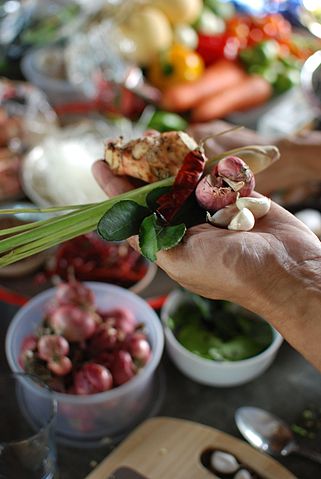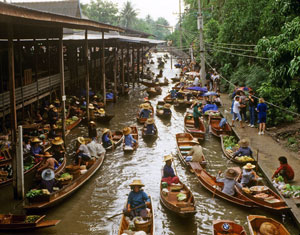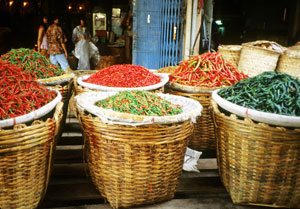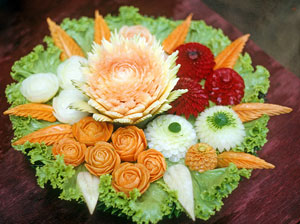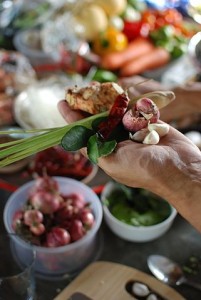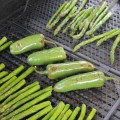When the weather starts to cool off, I begin to crave a hearty Thai curry. There’s something about the richness of red curry paste that is incredibly satisfying to the palate; in fact, I find that even a small portion of good red curry leaves me feeling sated—much more so than a comparable amount of Chinese food, for instance. Recently I decided to whip up some red curry using some leftover cooked pork loin I had in the fridge—the recipe is at the end of this article.
Here’s a bit of background about Thai curry, excerpted from A World of Curries by Dave DeWitt: In Thailand, the people believe that they had more time to evolve their unique cooking because they were smart enough to keep would-be foreign invaders at bay. Thailand is the only Asian country that was not subjected to European conquest, has rarely been overrun by its Asian neighbors, and it has seen relatively few wars. These unique conditions gave the Thai kings time to spend with their queens and mistresses, to hire the best cooks, and to encourage the cooks to create new dishes and improve the traditional ones. One Thai ruler who loved good food was Chulalongkorn, who reportedly had thirty-two wives. Every New Year he required each of his wives to prepare one new dish, and the wife who created the dish enjoyed most would receive special gifts and an elevated status.
Thai curries are extensively spiced with chiles. Contrary to popular belief, there is not just one “Thai chile,” but rather dozens of varieties used in cooking. When Dave toured the wholesale market in Bangkok in 1991, he found literally tons of both fresh and dried chiles in baskets and in huge bales five feet tall. They ranged in size from piquin-like, thin pods barely an inch long to yellow and red pods about four inches long. When making substitutions, cooks should remember that, generally speaking, the smaller a chile, the hotter it is.
It is the fresh chiles that are ground up with other ingredients to make the famous Thai curry pastes, but rehydrated dried chile can be substitued in a pinch. Two key curry pastes are the heart of Thai cooking; a red paste, called Nam Prik Gaeng Ped, uses red chiles, lemon grass, galangal and a number of herbs. Green curry paste is made with green Thai chiles, but serranos make a good substitute. It looks deceptively mild, like a Mediterranean pesto, but is very hot indeed. These pastes are easily made fresh, keep well for at least a month in the refrigerator, and add a terrific zing to curries, but some very tasty commercial curry pastes are available in Asian markets. A yellow curry paste, colored with ground turmeric, is perhaps the mildest among all Thai pastes.
A visitor to a Thai home or restaurant is won over by the aromatic food, but also by the elegant way it is served. Commonly accompanying Thai curries are elaborately carved fruits and vegetables, which often resemble large flowers. Rosemary Brissenden, author of Joys and Subtleties: Southeast Asian Cooking, described the art: “Fruit and vegetable carving is traditionally a highly cultivated art. Anyone who has watched the infinite calm of a Thai woman carving a piece of young ginger into the likeness of a crab with its pincers at ready will bear witness to this. Thai salads are also artistically arranged, and food historians believe that such elaboration dates back to the days of royal culinary competitions, when the dishes had to look as spectacular as they tasted.”
Nam Prink Gaeng Ped
(Red Curry Paste)
A popular ingredient in Thailand, this curry paste can be added to any dish to enhance its flavor. It is, of course, a primary ingredient in many of the famous Thai curries. Traditionally, it is patiently pounded by hand with a heavy mortar and pestle, but a food processor does the job quickly and efficiently. It will keep in the refrigerator for about a month.
10 small dried red chiles, such as piquins, stems removed
2 teaspoons ground cumin
2 teaspoons ground coriander
2 small onions
1 teaspoon black peppercorns
1/2 cup fresh cilantro
1/4 cup fresh basil or mint leaves
1 teaspoon salt
3 2-inch stalks lemongrass, including the bulb
1 1-inch piece of galangal, peeled
1 tablespoon chopped garlic
1 tablespoon shrimp paste
1 tablespoon corn or peanut oil
1 tablespoon lime zest
1/4 cup water
Soak the chiles in water for 20 minutes to soften, then remove and drain. Roast the coriander and cumin seeds for about 2 minutes in a dry skillet, and when they are cooled, grind to a fine powder in a spice mill.
Combine all ingredients in a food processor or blender and puree into a fine paste. Store it in a tightly sealed jar in the refrigerator.
Yield: About 1 cup
Heat Scale: Hot
Thai Red Pork Curry
I made this curry with some leftover cooked pork loin. It was perfect as the protein for my dish. I wimped out and used Thai Kitchen red curry paste out of a jar, but it was delicious and aromatic—and packed the heat I was looking for. If you use pre-made curry paste as I did, the most time-consuming aspect of this dish is chopping up the vegetables. Serve the curry over jasmine rice. Leftovers can be frozen for a tasty, quick lunch. If you have time to kill, you can carve up some vegetables into artful rosettes for garnish.
1-2 tablespoons olive oil
1 tablespoon red curry paste (or more if you like it really hot)
1 1/2 pounds cooked pork or chicken, cubed*
2 cloves garlic, chopped
1 large sweet onion, sliced
1 red bell pepper, chopped
1 large Japanese eggplant, peeled and cubed
1” length of fresh ginger, peeled and grated
1 fresh habanero, stem and seeds removed, finely chopped (optional)
8 ounces sliced mushrooms
1/4 cup chopped fresh cilantro
1/4 cup chopped fresh basil leaves
1 can coconut milk
1 1/4 cups chicken broth
1 teaspoon sugar (or to taste)
zest of 1 lime
1/4 teaspoon salt (or to taste)
Additional sprigs fresh cilantro for garnish
Quartered lime wedges for garnish
Heat oil in a wok to medium high and add the curry paste, stirring for 1 minute. Add the pork, stir-fry another couple of minutes, toss in the chopped garlic and onion and stir-fry until the onion begins to soften (about 3 minutes). Add the bell pepper, eggplant, ginger, mushrooms, and habanero, stir fry until the bell pepper begins to soften (about 8 minutes). Add the fresh basil.
Add the coconut milk, broth, sugar, lime zest, and season to taste with salt. Cook for a couple more minutes to meld the flavors, and serve.
*If you’re starting with raw pork, cut it into thin strips and cook it in the red curry paste and oil before adding the other ingredients.
Serves: 6
Heat Scale: Hot
Lois Manno
Latest posts by Lois Manno (see all)
- DIY Whole Wheat Flour Tortillas - 07/24/2018
- Green Chile Enchiladas - 07/23/2018
- SW Chocolate & Coffee Fest: A Caffeine Fiend’s Dream - 03/26/2013

